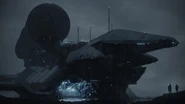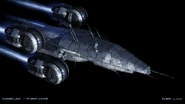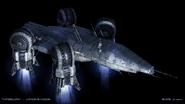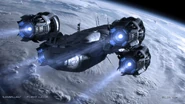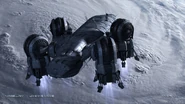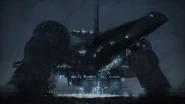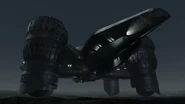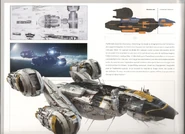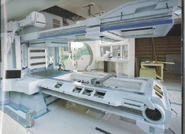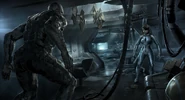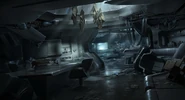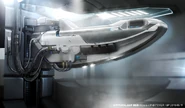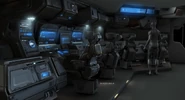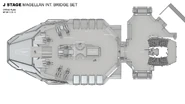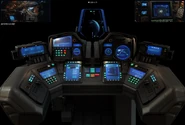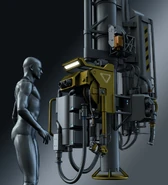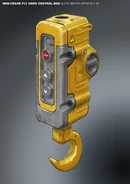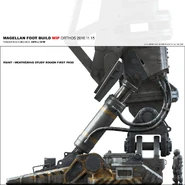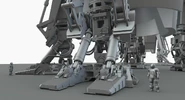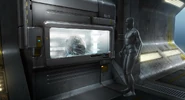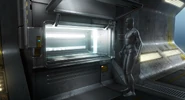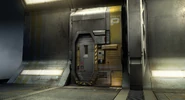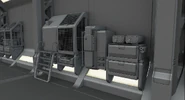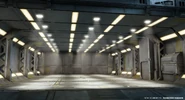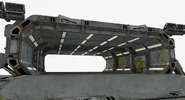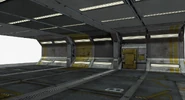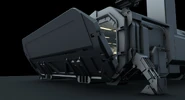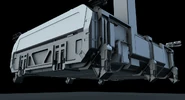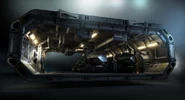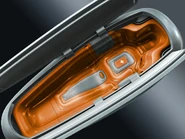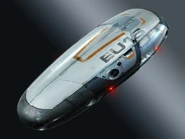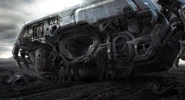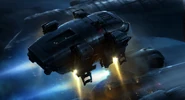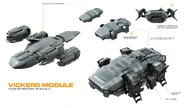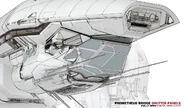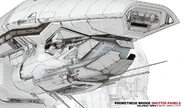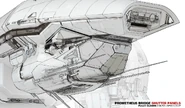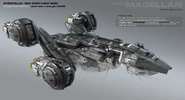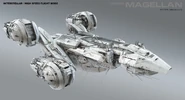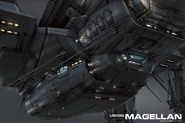The USCSS Prometheus was a Heliades-class space exploration vehicle built and operated by Weyland Corp and captained by Idris Janek. It was a revolutionary starship, and at the time of its launch was the most advanced and expensive faster-than-light space exploration vehicle ever constructed. It was billed as an official United States Commercial Starship in 2091.
Sent to the Zeta 2 Reticuli star system to investigate the moon LV-223 in 2091, the Prometheus arrived two years later in 2093; it was eventually destroyed in 2094, days later.
Development
Conceived and planned by Sir Weyland himself, Project Prometheus was Weyland Corp's most significant initiative. Weyland named the mission in honor of the Titan Prometheus from Greek mythology, who stole the secret of fire from the Gods and gave it to mankind; now, Weyland returns the favor by giving his own gift of fire to the masses, one that will guide the company and its investors to the ultimate truth via the USCSS Prometheus.
The mission of Project Prometheus is to seek out the actual origin of mankind, wherever it may be in space. Weyland Industries believes this voyage will yield extraordinary dividends for its investors; financially and spiritually. This mission is incredible in scope: not only do we endeavor to bring vital knowledge back to investors, but it will mark the furthest a human has ever ventured into our universe. Because of the high level of risk involved, Weyland has searched far and wide to find the most skilled, dedicated and exceptional professionals to contribute their expertise to the mission.
Project Prometheus
"From the company that gave the world its most advanced space vehicle of the 21st century, comes a new design even more impressive than the last. Heliades, the galaxy’s first ever FTL vehicle, has been the proud flagship of the Weyland Transportation division since 2034. Today, after thirty-eight years of development, Weyland announces the newest member of its impressive fleet: the larger, safer, FTL-capable, Prometheus.
The first mission of Prometheus is planned for next summer, 2073. Plans for Prometheus’ maiden voyage are already underway and Weyland Citizen Relations personnel anticipate record numbers of civilians turning out to watch this highly-anticipated event, as Prometheus rises from the launch pad en route to the stars for the first time. “She’s quite a ship,” admires Corin McManna, Heliades pilot and member of Prometheus test flight crew. I’ve flown hundreds of FTL missions on Heliades class vessels, but this would be the most exciting one yet.” Captain McManna plans to compete for the helm of the first Prometheus, along with several other highly-qualified FTL pilots. “I want this job,” states McManna, “But there is an extremely high calibre of candidates to beat out. It’ll be tough.”
Weyland spokesperson, William Concordov, notes that the Prometheus-class vessel will open up previously uncharted regions of space. "Prometheus can take us to KOI-2410 and beyond, past the furthest of our Weyland-built worlds," says Concordov. "Where Heliades leaves off, Prometheus picks up. And this is just the beginning. Who knows where Weyland will go next or what our Prometheus crews will discover while traveling to each of our unique terraformed colonies and beyond, extending the reaches of the known universe?"
History
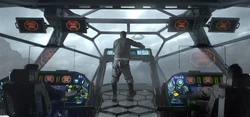
The bridge of the Prometheus.
In 2089, two archaeologists Elizabeth Shaw and Charlie Holloway discover a star map among several unconnected ancient cultures. They interpret this as an invitation from humanity’s forerunners, or "Engineers". Sir Peter Weyland, the elderly CEO of Weyland Corp, funds the creation of the scientific vessel Prometheus to follow the map to the distant moon LV-223.
The ship's crew travels in stasis while the android David monitors their voyage and studies linguistics such as Schleicher's fable. Arriving in 2093, they are informed of their mission to find the Engineers. Mission director Meredith Vickers orders them to avoid making contact without her permission. The Prometheus landed near a large artificial structure, which a team explores.
Events on LV-223
After the Prometheus lands on LV-223, Holloway, Shaw, David, Fifield, Millburn, and Ford suit up and leave to investigate the strange structures. Once they reach inside, David activates a hologram, leading to the discovery of a decapitated alien lifeform, leading to the even further discovery of a room with the statue of a huge head and several black urns inside. David steals an urn as the group leaves, but Millburn and Fifield get lost. Later, Prometheus is almost breached by a horribly mutated Fifield, who manages to kill seven crew members before being burned to death by Janek with a flamethrower. The situation becomes worse when Janek accurately theorizes that the Engineers planned on wiping humanity out and that the recently awakened Engineer plans on completing their mission.
The expensive vessel was destroyed when Shaw convinced Janek to stop the Engineer's spaceship from reaching Earth. Janek successfully crashes the Prometheus into the Engineer's ship, destroying the former ship and killing everyone on board, and saving Earth.
Crew
- Idris Janek — Captain
- Meredith Vickers — Mission Director
- Emun Chance — Pilot
- Benedict Ravel — Pilot/Navigator
- David 8 — Mission Attendant
- Elizabeth Shaw — Lead Scientist
- Charlie Holloway — Lead Scientist
- Rafe Millburn — Biologist
- Sean Fifield — Geologist
- Kate Ford — Medical Officer
- Corporal B. Jackson — Mercenary/Security Officer
- V. Furdik — Mercenary
- R. Sheppard — Mercenary
- L. Taplow — Mercenary
- S. Barnes — Mechanic
- J. Wallace — Mechanic
- Mechanic 3 — Mechanic
- Mechanic 4 — Mechanic
- Peter Weyland — Mission Sponsor (secretly aboard)
Cargo and Equipment
The Prometheus's propulsion system is four nuclear-powered ion plasma engines capable of VTOL thrust hybrid vectoring in atmospheric and interstellar conditions. Individual cranes in the engine's outer shell lifted the heavy landing gear back into the engine. The ship carried over twenty vehicles in tow along with crew weaponry composed of flame units, pistols, shotguns and Weyland Storm Rifles used by mercenaries in charge of security.
The main control room housed a primary table which received the signals fed by spectagraphs, which mapped out the Juggernaut as well as the Engineer temple. It also carried seventeen hypersleep chambers. Below is the ship's full list of included equipment:
- RT Series Group Transport: The RT Series Group Transport's shape-memory alloy wheel system has nano-reinforced hard-composite treads that resist temps up to 2000°F. Its ceramic gas turbine engine has .4 million pounds of thrust making its cargo weight virtually unlimited. With a 5.7 meter wheelbase, the personnel bay fits up to 20 occupants.
- ATV NR6: Two-person transport vehicle with 4-tread, track-belted wheels able to negotiate near-vertical terrain carrying small payload. With the NR6, Weyland planetary engineers are able to survey previously inaccessible areas of newly discovered proto-colonies. Vehicles reach top speeds of 88 mph in standard atmospheric pressure and gravitational pull. Variable-friction axes for front and rear wheels provide micro-torque gear adjustments for maximum safety and mobility across any foreign surface.
- Hypersleep chamber: A holographic display communicates with ship’s mainframe to monitor metabolic conditions to suspend cell function. The hypersleep chambers can be programmed to initiate, maintain and terminate hypersleep stasis of human crew depending on length of mission and percent FTL travel. Zero-loss lithium ion batteries in a tertiary backup system support the chamber’s function for up to 100 years in case of emergency. Hypersleep maintenience overseers can start dream-reading via establishing a neuro link through a visor.
- Class-D crew escape module: Vickers' suite was revealed to be a lifeboat when it ejected from the Prometheus and crash landed immediately. It was later seen again when Shaw confronted the Engineer. Exclusively designed for FTL crafts of a suitable size, this emergency sustaining pod is an embedded safety module comprised of 7 luxury-appointed rooms, complete with independent navigation and piloting controls. Reclaiming decontamination system allows one occupant 50 years of breathable air with or without hypersleep.
- Class-A individual crew ejection pod: The Prometheus apparently contains eight and they are automatically launched. When Vickers escaped from the Prometheus, the ship's automatic launch system ejected the pod from the ship; the pod flew itself for a few seconds before crash-landing on the ground.
- Pauling MedPod 720i: Procedures include concentrated antibiotic injections, basic wound repair, appendectomy, laparoscopic ablation and Cesarean section. The MedPod can diagnose, treat and perform a range of surgical procedures with ultra-fine laser incisions guided by 3D anatomical scanning. David calibrated the one on board the Prometheus to attend male patients, but Shaw was able to bypass the system and have a foreign body extraction surgery to remove her offspring.
- Intergalactic comm antennas: The ship had many installed all around the front, similar to the USCSS Nostromo.
- Weyland space suits: Used in exploration, reconnaissance and for tactical maneuverability in the field. Nano-reinforced composite helmet allows a 320° rotational field of vision with info display of vital stats, environmental conditions, communications systems and data analysis. Cadmium exoskeleton provides safety and stability over rough terrain. Iridium-coated, laser resistant light armor optional.
Behind the Scenes
The interior of the ship was built across a two level structure, fronted by a large, faceted, wrap around windscreen; this element of the design, along with the "floating" crew positions that projected into this windshield, were recycled from an unused original design for the Nostromo's bridge in Alien.[4] Vickers' quarters were designed to represent her high status on the ship, being furnished with modern and futuristic items including Swarovski chandeliers and a Fazioli piano. The ship's garage was built on the backlot of Pinewood Studios in England.
Trivia
- NASA actually established a Project Prometheus in 2003 to develop nuclear-powered systems for long-duration space missions; this project was also named after the Titan Prometheus from Greek mythology.
- In Jon Spaihts' original script for Prometheus, titled Alien: Engineers, the Prometheus is known as the Magellan.[5] Several pieces of concept art for the ship also carry this early name.
- It has been speculated that the Prometheus borrowed some design features from the Serenity (the Firefly-class transport ship from the TV series Firefly and its movie sequel, Serenity). These features include its rotating engines, which allow for vertical take-off and landing, and the fact that its cargo bay opens towards the front of the ship, although the latter is also a feature of the UD-4L Cheyenne Dropship from Aliens.
Appearances
- Prometheus
- Prometheus: Fire and Stone (mentioned only)
- Alien: The Weyland-Yutani Report
Gallery
Concept Art
References
- ↑ 1.0 1.1 1.2 S. D. Perry. Alien: The Weyland-Yutani Report, p. 45 (2014), Insight Editions.
- ↑ Jon Spaihts, Damon Lindelof (writers), Ridley Scott (director). Prometheus (2012), 20th Century Fox [DVD].
- ↑ S. D. Perry. Alien: The Weyland-Yutani Report, p. 46 (2014), Insight Editions.
- ↑ Paul Scanlon, Michael Gross. The Book of Alien, p. 44 (1979), Heavy Metal Press.
- ↑ "Alien: Engineers" by Jon Spaihts
- ↑ Prometheus - Weyland Corp Archive Second Screen App





























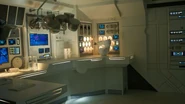
![Prometheus blueprint.jpg (139 KB) A blueprint of a section of the Prometheus.[6]](https://static.wikia.nocookie.net/avp/images/5/5a/Prometheus_blueprint.jpg/revision/latest/scale-to-width-down/185?cb=20140119062405)
